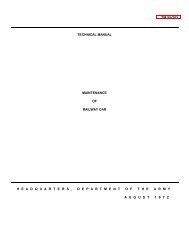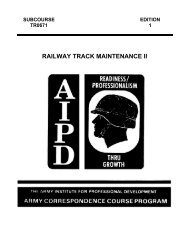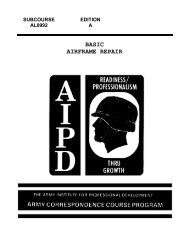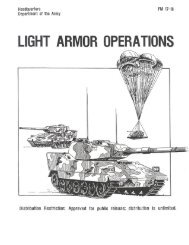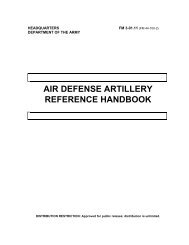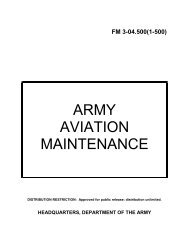fm 44-100 us army air and missile defense operations
fm 44-100 us army air and missile defense operations
fm 44-100 us army air and missile defense operations
Create successful ePaper yourself
Turn your PDF publications into a flip-book with our unique Google optimized e-Paper software.
FM <strong>44</strong>-<strong>100</strong><br />
1-6<br />
1-30. An <strong>air</strong>craft threat has fixed nature <strong>air</strong>craft-related support facilities,<br />
th<strong>us</strong> making the operational battlespace (opportunities to engage) much<br />
greater. Aircraft conducting <strong>operations</strong> against the force are exposed to<br />
defensive fires for tens of minutes, while <strong>missile</strong> engagement opportunities<br />
are measured in seconds.<br />
1-31. The unique challenges posed by theater <strong>missile</strong> <strong>defense</strong> require a highly<br />
responsive C2 structure, which decentralizes engagement <strong>operations</strong> to the<br />
lowest level. By comparison, the requirement to avoid fratricide of friendly<br />
<strong>air</strong>craft m<strong>and</strong>ates strict, highly centralized control of theater <strong>air</strong> <strong>defense</strong><br />
engagements.<br />
HISTORICAL PERSPECTIVE<br />
1-32. World War II offered lessons about modern warfare that remain<br />
relevant 50 years later. Army divisions joined both joint <strong>and</strong> allied forces in<br />
the conduct of combined arms, force-projection <strong>operations</strong> supported by<br />
modern fighter <strong>air</strong>craft <strong>and</strong> bombers. Enemy <strong>air</strong> forces were large, <strong>and</strong> highly<br />
capable, <strong>and</strong> had the potential to deliver both conventional <strong>and</strong> chemical<br />
munitions. They held US <strong>and</strong> allied forces at risk throughout the duration of<br />
the war. In addition to the <strong>air</strong> threat, the allies faced attack by surface-tosurface<br />
<strong>and</strong> cruise <strong>missile</strong>s. To counter the introduction of sizeable enemy <strong>air</strong><br />
forces, the Army developed <strong>and</strong> fielded equally capable <strong>air</strong> <strong>defense</strong> forces.<br />
Early experiences at Kasserine Pass <strong>and</strong> in the Pacific taught the importance<br />
of <strong>air</strong> <strong>defense</strong> to force protection. By 19<strong>44</strong>, comm<strong>and</strong>ers routinely integrated<br />
<strong>air</strong> <strong>defense</strong> forces into Army <strong>operations</strong> at all echelons.<br />
1-33. The Norm<strong>and</strong>y campaign of June 19<strong>44</strong>, <strong>and</strong> the subsequent breakout,<br />
provides excellent examples of <strong>air</strong> <strong>defense</strong> <strong>operations</strong> in a force-projection<br />
scenario. Eleven battalions of anti<strong>air</strong>craft artillery (AAA) supported the<br />
assaulting US divisions. As the beachhead exp<strong>and</strong>ed, additional AAA groups<br />
<strong>and</strong> brigades joined the assault forces to form a near-leak-proof <strong>defense</strong>.<br />
Though the Luftwaffe flew tho<strong>us</strong><strong>and</strong>s of sorties against the forces <strong>and</strong> assets<br />
concentrated in the beachhead, the allies suffered no significant damage due<br />
to <strong>air</strong> attack. American anti<strong>air</strong>craft artillery met the challenge by destroying<br />
more than 300 enemy <strong>air</strong>craft.<br />
1-34. Following bloody hedgerow fighting, American forces conducted a<br />
breakout in July 19<strong>44</strong>. The plan fully integrated <strong>and</strong> synchronized AAA with<br />
ground force <strong>operations</strong>. AAA again successfully protected the maneuver<br />
forces as they swept across France, destroying more than 300 German<br />
<strong>air</strong>craft. As units moved forward, the allies captured new ports for <strong>us</strong>e as<br />
forward logistics centers. The Germans made a determined effort to destroy<br />
the major port, Antwerp, <strong>us</strong>ing V-1 <strong>air</strong>craft, the first cruise <strong>missile</strong>s.<br />
American <strong>air</strong> defenders rose to the challenge, destroying more than 70<br />
percent of the <strong>missile</strong>s <strong>and</strong> keeping the port open throughout the five-month<br />
attack.<br />
1-35. Operation OVERLORD is ill<strong>us</strong>trative of the steps taken in a forced<br />
entry, force-projection operation. Air <strong>defense</strong> protected the force in the points<br />
of embarkation <strong>and</strong> throughout entry <strong>operations</strong>, expansion of the lodgment,<br />
<strong>and</strong> conduct of decisive <strong>operations</strong>. The threat posed by enemy <strong>air</strong>craft <strong>and</strong>




